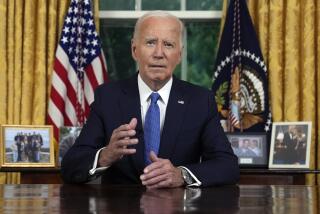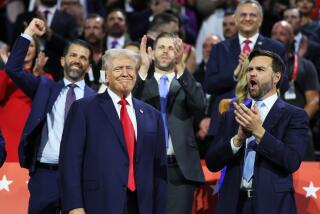Bush Hails Victory in Iraq
- Share via
ABOARD THE USS ABRAHAM LINCOLN — Against a carefully arranged backdrop of fighter jets, cheering sailors and azure seas, President Bush savored the victory in Iraq, declaring Thursday that “the United States and our allies have prevailed.”
“Operation Iraqi Freedom was carried out with a combination of precision, speed and boldness the enemy did not expect and the world had not seen before,” Bush said. In a veiled warning to anyone else who might cross the United States, he added, “You have shown the world the skill and might of the American armed forces.”
For the record:
12:00 a.m. May 4, 2003 For The Record
Los Angeles Times Sunday May 04, 2003 Home Edition Main News Part A Page 2 National Desk 1 inches; 58 words Type of Material: Correction
Bush speech -- An article Friday in Section A about President Bush’s visit to the aircraft carrier Abraham Lincoln said it marked the first speech by a president aboard a moving aircraft carrier. In fact, at least one president preceded Bush: President Clinton gave a speech aboard the Theodore Roosevelt off the coast of Virginia in March 1993.
Bush took delight in the setting and the message he had come to deliver: that despite doubts at home and abroad, the war in Iraq had been quick, impressive and apparently decisive.
The speech -- the first by a president aboard a moving aircraft carrier -- described the campaign against Iraq as a “battle” that is but “one victory in a war on terror that began on Sept. 11, 2001, and still goes on.”
“The liberation of Iraq is a crucial advance in the campaign against terror,” said Bush, who flew to the carrier aboard a four-seater reconnaissance aircraft, taking the controls for part of the flight. “With [the 2001] attacks, the terrorists and their supporters declared war on the United States. And war is what they got.”
He also gave perhaps his most optimistic assessment so far of that campaign: “The war on terror is not over, yet it is not endless. We do not know the day of final victory, but we have seen the turning of the tide.”
Bush launched the Iraq war six weeks ago with an Oval Office address following a strike that targeted Saddam Hussein in Baghdad. The fate of the Iraqi leader remains uncertain.
Although Baghdad fell just three weeks later, the White House has avoided formally declaring an end to the war. One reason is that hostilities may yet flare from what U.S. officials describe as “pockets of resistance.”
Another reason appears to be the president’s decision to adopt wording that downgrades the Iraqi conflict from a war to a “battle” and that integrates it more fully than before with the war on terrorism.
Bush’s visit to the carrier, which is headed toward San Diego, was the result of a week of meticulous planning by White House aides, eager to cement the president’s image as a victorious commander in chief. Much of the stagecraft -- including a banner reading “Mission Accomplished” -- was reminiscent of a campaign appearance.
Officers even made certain that land would not be visible in the background as the president spoke.
In his speech, Bush said the conflict with Iraq marked the beginning of “a new era” in waging war. Advances in military technology have enabled U.S. forces to reduce -- instead of increase -- death and destruction, the president said.
“In defeating Nazi Germany and imperial Japan, Allied forces destroyed entire cities, while enemy leaders who started the conflict were safe until the final days,” Bush said. “Today ... with new tactics and precision weapons, we can achieve military objectives without directing violence against civilians. No device of man can remove the tragedy from war. Yet it is a great advance when the guilty have far more to fear from war than the innocent.”
The president also briefly referred to the new bid to resolve the Israeli-Palestinian conflict, linking it to the war on terrorism. “We are committed to freedom in Afghanistan, in Iraq and in a peaceful Palestine,” he said.
The president’s speech brought the conflict with Hussein’s Iraq to an end, but Bush repeated that the next stage -- reconstruction -- will be difficult and require serious commitment.
“The transition from dictatorship to democracy will take time, but it is worth every effort,” Bush said. “Our coalition will stay until our work is done. Then we will leave -- and we will leave behind a free Iraq.”
The speech barely made reference to weapons of mass destruction, even though they played a central role in the president’s initial rationale for the war. None have been found so far, but Bush expressed confidence that they would be.
“We have begun the search for hidden chemical and biological weapons and already know of hundreds of sites that will be investigated,” he said.
Bush also reiterated his policy, stated often since the Sept. 11 attacks, that “any person involved in committing or planning terrorist attacks against the American people becomes an enemy of this country and a target of American justice.”
He added, “Any outlaw regime that has ties to terrorist groups, and seeks or possesses weapons of mass destruction, is a grave danger to the civilized world and will be confronted.”
Bush, dressed in a dark business suit and red tie, ended the speech with thanks for the services of those aboard the carrier.
“All of you -- all in this generation of military -- have taken up the highest calling of history. You are defending your country and protecting the innocent from harm,” he said.
The Abraham Lincoln, commissioned in 1989 by then-Defense Secretary and current Vice President Dick Cheney, returns to port in San Diego today after a 10-month, 100,000-mile cruise. Bush noted that it was “the longest carrier deployment in recent history.”
Although his audience applauded throughout his remarks, the loudest cheers came after Bush said: “Americans, following a battle, want nothing more than to return home. And that is your direction tonight.”
He also noted that 150 babies were born home to sailors and airmen while they were away.
The lengthy mission was not entirely by design. The Lincoln, which deployed July 20 with more than 5,000 sailors and airmen, was on its way home in December when it was ordered back to the Persian Gulf.
During the Iraq war, the ship and its aircraft conducted reconnaissance flights, gathered intelligence and made more than 16,000 sorties. Many of those were bombing runs that dropped 1.2 million pounds of ordnance on Iraqi targets -- more than a third of the total of 3 million pounds dropped during the air war.
Bush flew to the aircraft carrier aboard an S-3B Viking submarine reconnaissance aircraft, used for refueling missions during the Iraq war. The president, who served as a pilot in the Texas Air National Guard during the Vietnam War, was at the controls for about half the 30-minute flight. A co-pilot and Secret Service officer looked on from the rear seat.
The president described the experience as “really exciting.”
“I miss flying, I can tell you that,” he said.
Pilot Skip Lussier described the president as confident at the controls.
“It came back to him,” he said. “It was like riding a bicycle. He had a great time.”
Lussier, 39, said he and the president talked about flying and about the accomplishments of the carrier and its battle group. Lussier took the controls for the cable-assisted landing, in which the aircraft’s tailhook catches a cable to pull the plane to a quick stop before it reaches the end of the flight deck. The Viking caught the fourth of four cables.
“Next to the birth of my kids, this is the greatest day of my life,” Lussier said.
The Viking was designated Navy One for the flight, which means the commander in chief was aboard. The aircraft had been decorated accordingly, with “Navy 1” painted on the side of the tail, and “George W. Bush, Commander-in-Chief” stenciled below the amber-tinted windshield.
Wearing an olive green flight suit, Bush disembarked from the Viking and removed his helmet out of sight of TV cameras. He carried it jauntily under his left arm as he made his way into the crowd of sailors, patting them on the back, shaking their hands and posing for photographs.
“This is the highlight of my Navy career,” said Arnold Tutson, a 22-year-old firefighter. “It’s not so often people can say they shook hands with the president, especially after such a long deployment.”
To read the full text of Bush’s speech, go to latimes.com/bushtext.
*
Reynolds reported from San Diego and Gorman from aboard the Abraham Lincoln.
More to Read
Get the L.A. Times Politics newsletter
Deeply reported insights into legislation, politics and policy from Sacramento, Washington and beyond. In your inbox twice per week.
You may occasionally receive promotional content from the Los Angeles Times.










